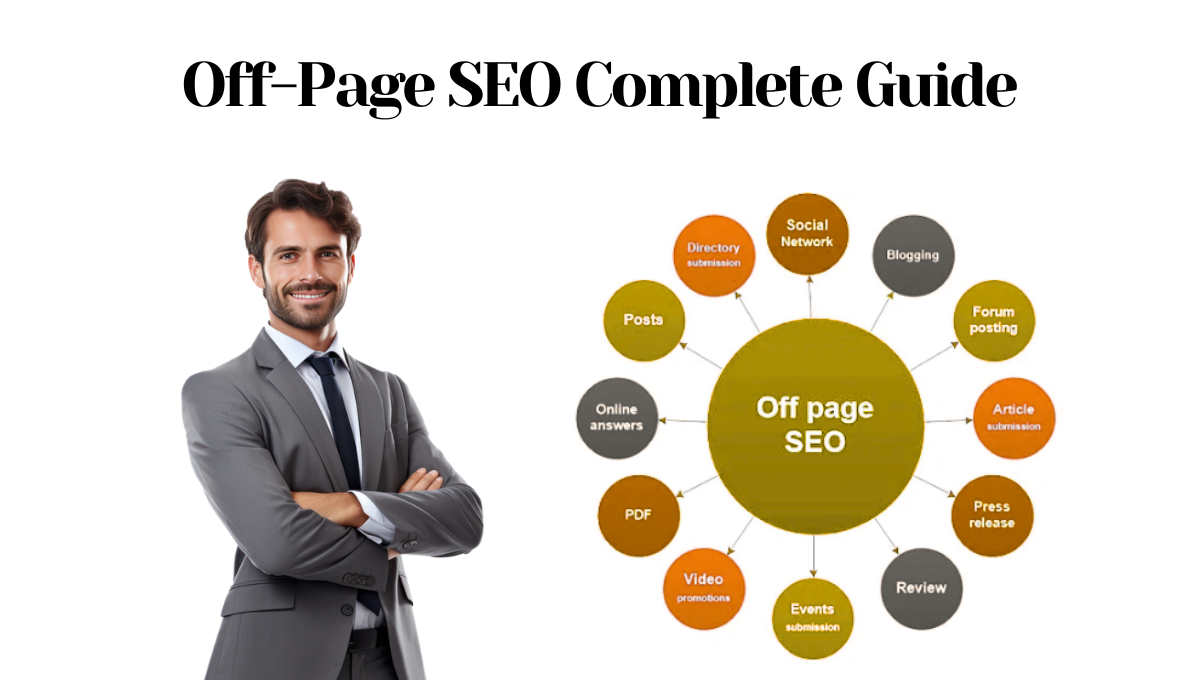Did you know? In just 0.05 seconds, a visitor decides what they think of your website! The design is what makes them stay or leave after that quick decision. 94% of first impressions are influenced by the design of your website, yet an unsuccessful redesign can reduce organic traffic by as much as 70%. In 2025, it will be essential to understand how to redesign a website without losing SEO.
Redesigning your website is a great way to update the user experience, increase conversions, and renew your online presence. However, you run the risk of reversing years of hard-earned rankings if you don’t have a good SEO checklist for website redesigns.
So, how to redesign a website without losing SEO? The solution combines technical planning, careful execution, and strategy. Using a website redesign SEO checklist made for the contemporary web, let’s take it step by step.
1. Pre-Redesign Planning & Goal Setting
If you don’t have a plan for your redesign, it’s like navigating without a map; you’ll get lost quickly. Make sure your website redesign requirements are clear before you write a single line of code. Are you trying to increase user engagement, update your branding, or speed up your website? To keep your website redesign project on track, set SMART goals (Specific, Measurable, Achievable, Relevant, Time-bound). The following is a detailed plan before you begin designing.
- Establish your main goals (improving mobile performance, increasing conversions, and improving UX).
- Establish quantifiable KPIs, such as improving average session duration, increasing organic leads, or lowering bounce rate by a given percentage.
- Enumerate every requirement for a website redesign, including any technical enhancements, rebranding components, or accessibility features.
- A solid plan guarantees that your website redesign supports SEO and business objectives from the outset.
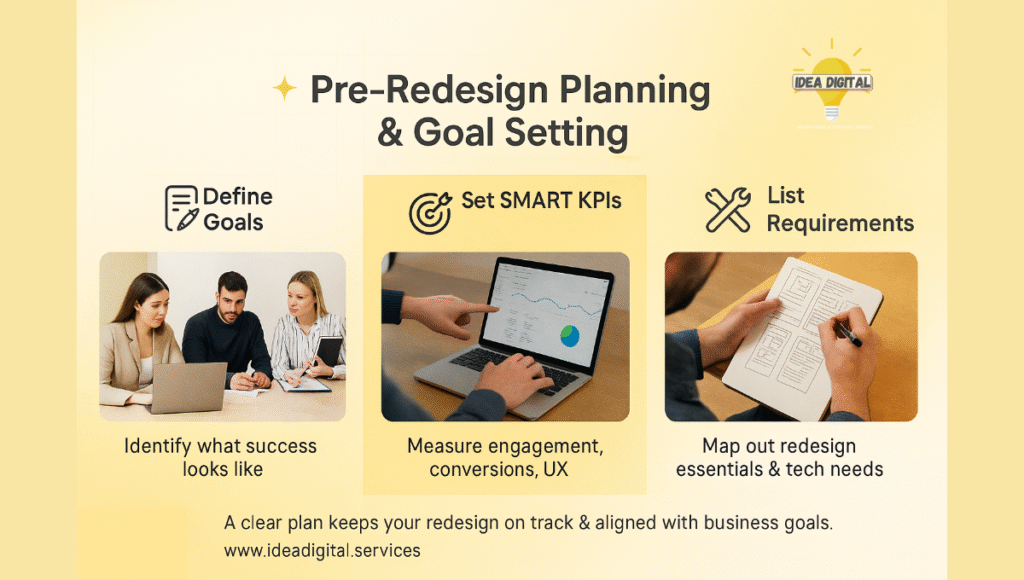
2. Conduct a Comprehensive SEO Audit
A full SEO audit is the first step to a successful website redesign. Before you start tearing down your old site, check its current SEO health very carefully. This audit shows you what you need to keep and what you can improve during your redesign.
Important parts of your SEO audit are:
- Identify the pages that receive the most traffic and maintain their structure and content.
- Look at your backlink profile to see which pages give you authority.
- Look at the current keyword rankings to see what’s working.
- Use Google Search Console to find and record crawl errors and problems with indexing.

3. Keyword Mapping & Site Architecture Planning
Your keywords and the way your site is set up help both people and search engines. Redesigning without careful planning can cause a significant drop in traffic. Best ways to plan a site and map keywords:
- Give each important keyword its page.
- Plan any changes to your URLs ahead of time and set up 301 redirects to keep your SEO equity.
- Make the navigation structure easier to understand and use to make it better for users and easier for search engines to crawl.
- A good architecture and keyword strategy will help you stay on track with your SEO for website redesign.
| Current URL | Target Keyword | New URL | Action |
| /blog/seo-tips | SEO tips | /resources/seo-tips | 301 redirect |
| /services/design | web design | /web-design | 301 redirect |

4. Technical SEO & Infrastructure Setup
The technical backbone of your website is what makes all of your SEO and design work worth it. Technical SEO fixes during a redesign make your site stronger and faster, which is very important for 2025. Taking care of these things early will keep your search presence safe while you work on your website.
Basic technical SEO:
- To get better rankings and a better user experience, make your pages load in less than 2.5 seconds.
- Make sure your site works well on mobile devices so that Google can index it first.
- Use HTTPS to protect user data and gain their trust.
- Update and submit XML sitemaps, and make robots.txt settings better for crawling.
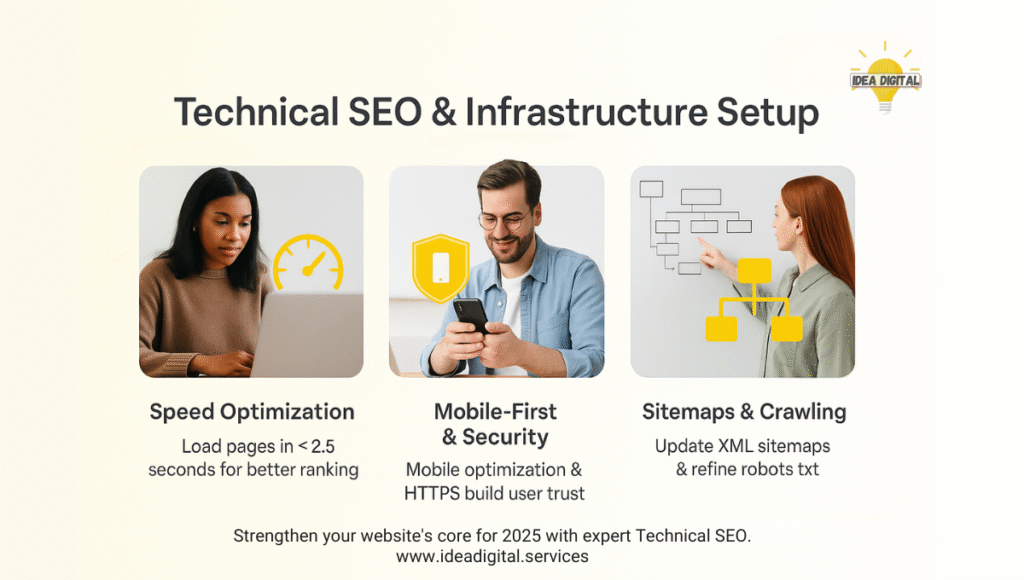
5. On-Page SEO Optimization
If no one can find your appealing new website, what purpose it? Making your website an SEO powerhouse that draws and keeps organic traffic is the goal of a successful redesign, not just improving its appearance. The ideal opportunity to improve your on-page SEO is with a new design. To increase visibility and generate more natural traffic, all of the components on your pages should cooperate. By adding these changes to your website redesign SEO checklist, you can maintain and even improve your rankings.
Key areas to concentrate on:
- Add compelling calls to action and updated keywords to meta titles and descriptions.
- Improve the content structure and SEO relevance of the header tags (H1, H2, and H3).
- Images can be made more accessible and search engine visible by adding informative alt text.
- Boost internal linking to enhance authority flow and site navigation.
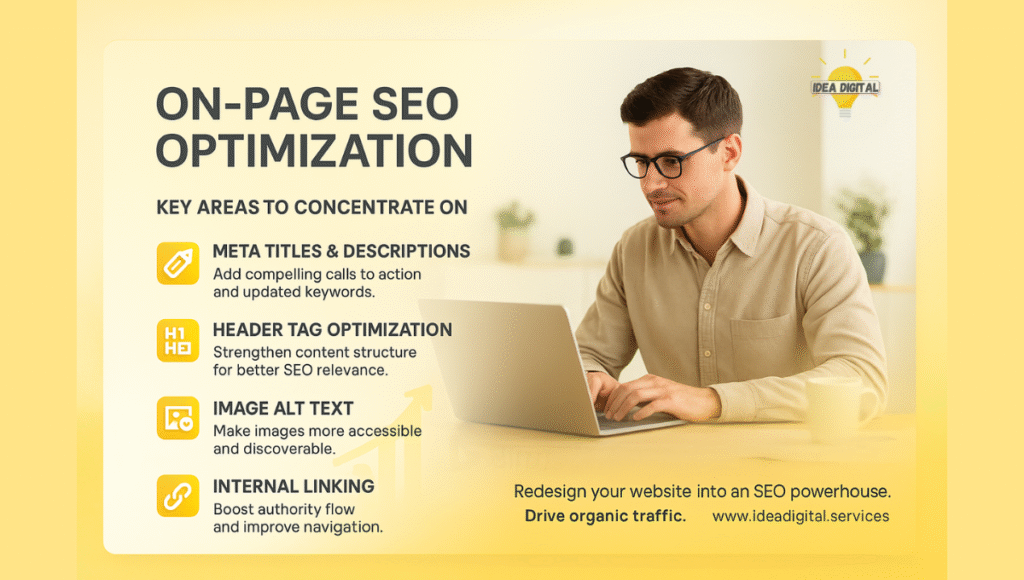
6. Content Review & Migration Strategy
The content you put out there is what will help you rank higher in search engines and gain users’ trust. It’s a great time to look at and improve your website during a redesign, but be careful not to lose any SEO value. A clear plan makes sure that your website redesign project builds on your content strengths instead of losing them.
Here are some steps to make sure the migration goes smoothly:
- Look over the content you already have and decide what to keep, change, or get rid of.
- Make a detailed plan for 301 redirects to keep link equity and prevent 404 errors from happening.
- Before moving, make sure to back up all of your content so that you can get it back quickly if something goes wrong.
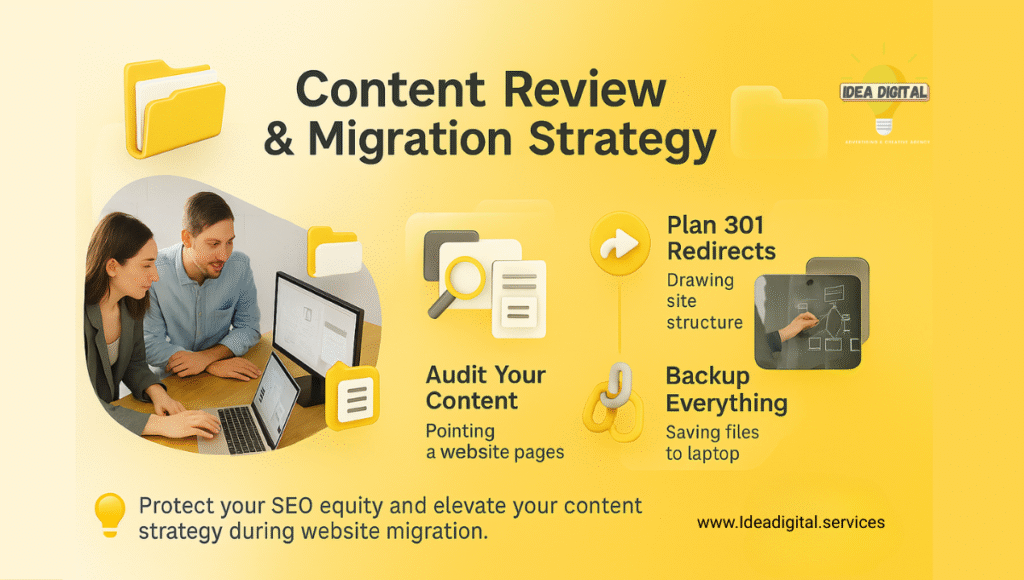
7. UX Testing and Quality Assurance (QA)
Did you know that a page that takes even one second longer to load can lose 20% of its conversions? It’s proof that no matter how appealing your redesign is, users will only stay interested and get results if it works quickly and smoothly.
UX testing makes sure that your new website is easy to use and helps with SEO. A smooth user experience helps you reach your SEO and website redesign goals by keeping visitors interested and lowering bounce rates.
Things you should check are:
- Make sure that all CTAs, forms, and navigation menus work and are easy to use.
- Make sure that the design and performance are the same on all browsers and devices.
- During testing, fix any links that don’t work or content that is missing.
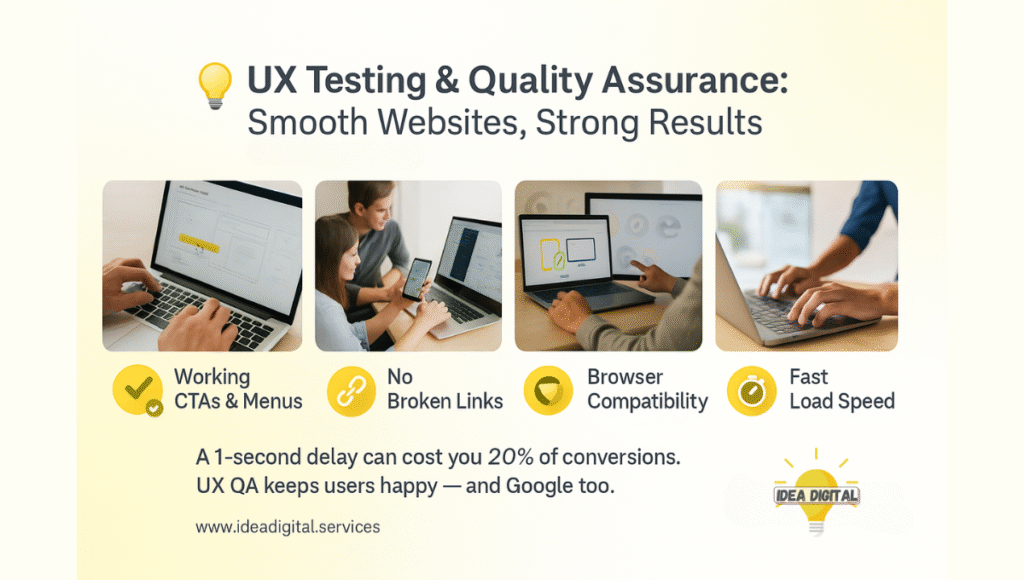
8. Launch and Post-Launch SEO Monitoring
Your launch day is not the end of the SEO process; it’s the start of something new. Keeping an eye on post-launch metrics is very important for keeping and improving your rankings. Monitoring your website redesign project all the time protects your investment and helps you find and fix problems early.
Important things to do after launch:
- Keep a close eye on traffic and keyword rankings for any sudden changes.
- For faster indexing, send Google updated XML sitemaps.
- Look for move errors and fix them right away to avoid losing traffic.
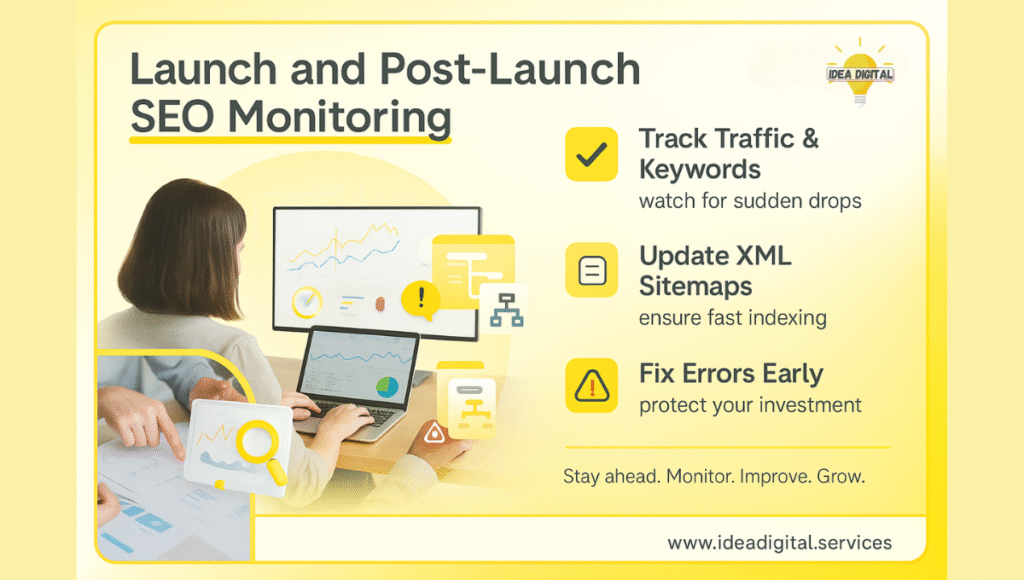
9. Iterative Optimization & Ongoing Maintenance
Once your new website is live, SEO doesn’t stop. Regular updates and optimisations are necessary to keep your online presence strong and growing. Ongoing improvements make sure that your website redesigns keep working and help you reach your growth goals.
What to keep in mind all the time:
- To keep your content fresh and useful for your audience, update it often.
- Do regular technical audits to fix problems like slow page loading, broken links, or security holes.
- Keep an eye on how well your keywords are doing and change your plan to stay ahead of the competition.
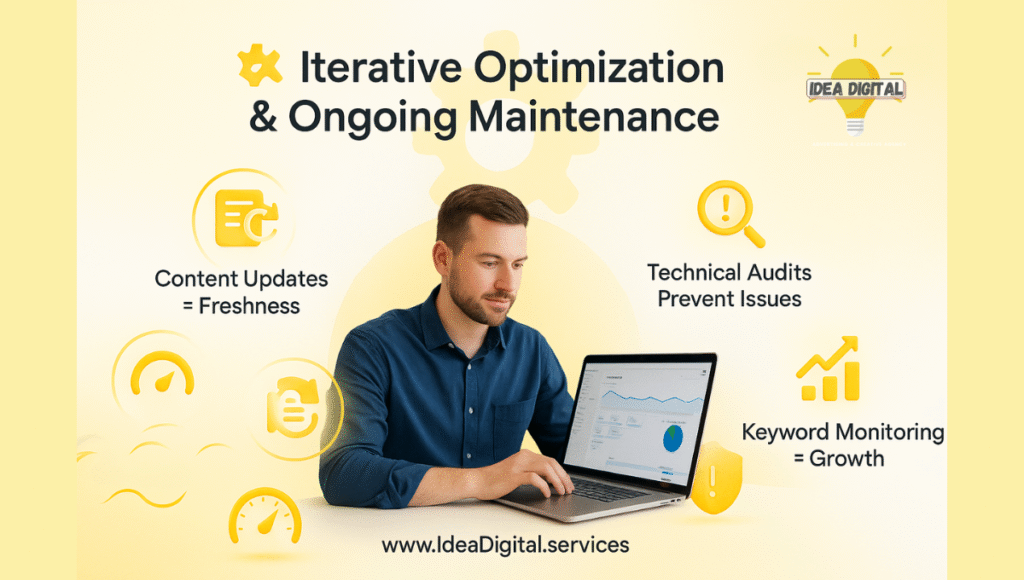
10. Bonus: Maximum SEO Impact Tactics
Want to take your redesign even further? Advanced strategies can help your site not only stay alive but also do well in 2025. Adding these tips to your SEO checklist for your website redesign will help you get the most out of your redesign money.
More ways to improve SEO:
- Improve the Core Web Vitals metrics to make the user experience better and the search rankings higher.
- Use structured data to get rich snippets and make your site more visible in search results.
- To get the most conversions, use A/B testing on pages that are worth a lot.
- To rebuild and grow your authority, reach out to the right people to strengthen your backlink profile.
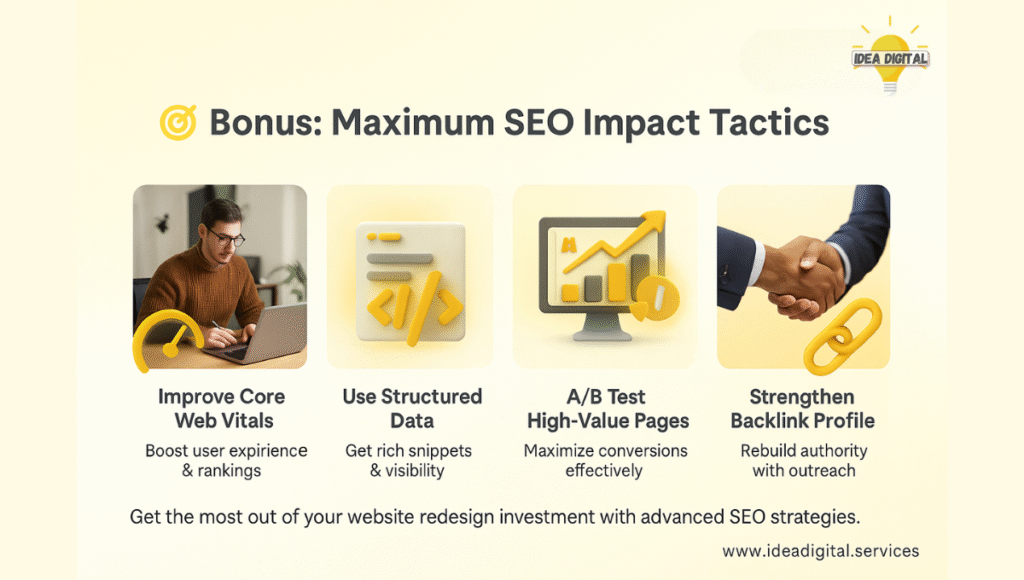
Conclusion: Launch Confidently & Rank Higher in 2025
If you do it right, a redesign of your website can change the game for your brand. This step-by-step guide will show you how to redesign your website without losing SEO. You can end up with a modern, beautiful site that not only gets attention but also ranks higher and keeps visitors interested. A successful redesign is more than just new pictures. It’s a smart investment that boosts your brand image, protects your existing SEO equity, speeds up and makes your site easier to use, and ultimately leads to long-term growth.
Your new website should stand out in search results and wow everyone who visits it. Your redesign can help you grow steadily through 2025 and beyond if you plan it well, pay attention to the details, and keep up with SEO.
We are a trusted website redesign service that helps brands make beautiful, high-performing websites that not only look good but also do very well in search rankings. Want to change your website without losing the SEO success you’ve worked so hard for?
Contact us today to find out how our website redesign services can help you launch with confidence and take over the search results in 2025.
FAQ’S
Can I redesign my website without affecting SEO at all?
It’s hard to avoid any impact, but you can greatly lower your risks and often improve your rankings after a redesign by following a detailed SEO-focused plan like the one above.
How long does a website redesign usually take?
Depending on the size and complexity of the site and how much SEO preparation and testing needs to be needed, a typical website redesign project can take anywhere from two to four months.
Do I need to hire a website redesign company for SEO-friendly results?
If SEO is important to you, you should hire a professional website redesign company or use expert website redesign services. They make sure that your new site looks great and keeps (or improves) its search rankings
.



